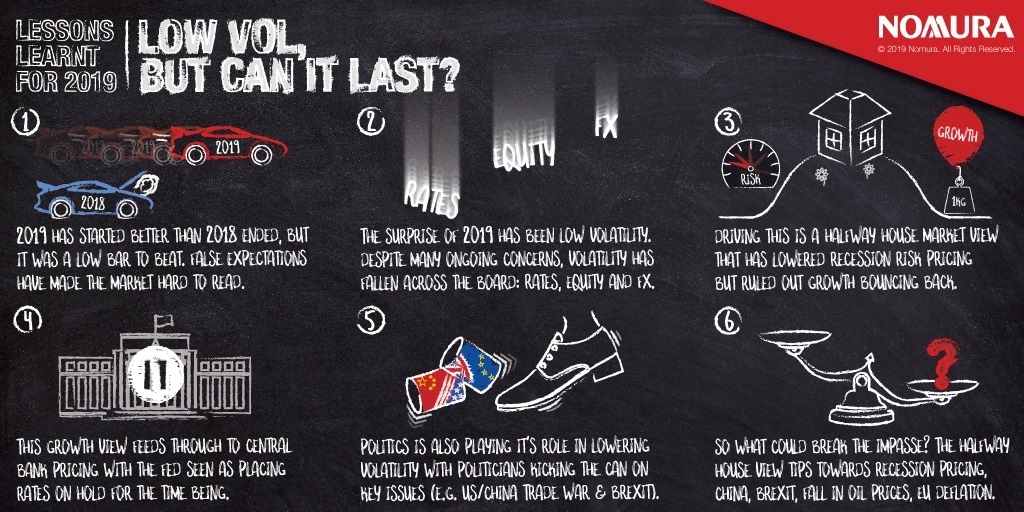Low volatility is not necessarily a bad thing; in fact it’s a defining characteristic of what we call “the good times.” However it plays a part of asset price bubbles, and mispriced risks in markets leading to equally large drawdowns as a result. One thing we can say is that when volatility eventually does rise, the low volatility regime may seem like a distant memory we want to go back to.
2018 to now
December 2018 really disappointed - we witnessed a 16% high to low in US equity markets into the year-end and financial conditions tightened in a fashion that warranted action from policy makers. The extremity of the market moves saw the pricing of a US recession over the next 12 months rise to a high of 40% (depending on your preferred model of measurement). The power of hindsight means we can deliver the good news which is that the market’s immediate recession pricing is lower now, but still rising at an uncomfortable rate.
Just take your pick of major global equity indices and it’s green across the board for year to date return showing that a lot has taken place over the past three months or so, but volatility for Rates, Equities and FX are all near their historical lows.
What is driving low volatility?
Market prices are relative - a share price rising is also the same as saying the value of the USD against that share is falling. In FX markets it's the same but on a country level. When looking into this there are three causal factors to consider:
- If both countries face the exact same economic pressures, what is there to say the value of their currency vs the other should be materially different?
- One structural trend that is unlikely to go away is the high levels of globalisation tying economies to each other and to the global environment with trade in goods and services at ~29% of World GDP.
- Growth rates between countries are not as wide as they once used to be and this is broadly reflected in the high correlations between global interest rates too.
When the US slows down, Europe tends to as well. It’s hard to argue using the growth and inflation frameworks (the bread and butter of FX analysis), to say why the USD should weaken when the Eurozone is facing similar headwinds.
So with it we come to the conclusion that markets are in a halfway house between one another and volatility falls with it.
What could send volatility higher?
The politics in Italy, a no deal Brexit, US-China trade talks falling apart or grey swans such as a debt bubble popping in China are all valid candidates to impact volatility levels. But as we’ve seen over recent years these political headlines see only short-lived spikes in volatility that tend to resolve themselves relatively quickly, or have had low cross-market contagion effects.
Two big factors with longer-lasting effects could emerge:
1) Central bank pricing to move and preferably diverge from one another. With the ECB at or near the zero lower bound, it’s required a conversation about tiering interest rates that would allow for more flexibility to respond to the downturn. But until we get a decision there the relevant monetary policy pricing is more likely to be driven only by the USD leg of the equation. Which already prices in 1-2 cuts over the next two years from the Fed and on its own probably won’t be enough to warrant a spike higher in volatility.
2) The big recession trade is a curve steepening; with it will be FX volatility: It’s when the market turns from pricing a slowdown in the US economic cycle into a recession that we get the real spike in volatility. We’re not calling for a recession in the US, but can’t help take note that it’s probably not long until the 2s10s US curve does eventually invert and it’s historically been the market’s best forecaster of a recession soon to come.
For more information read FX Vol: How low can you go?




